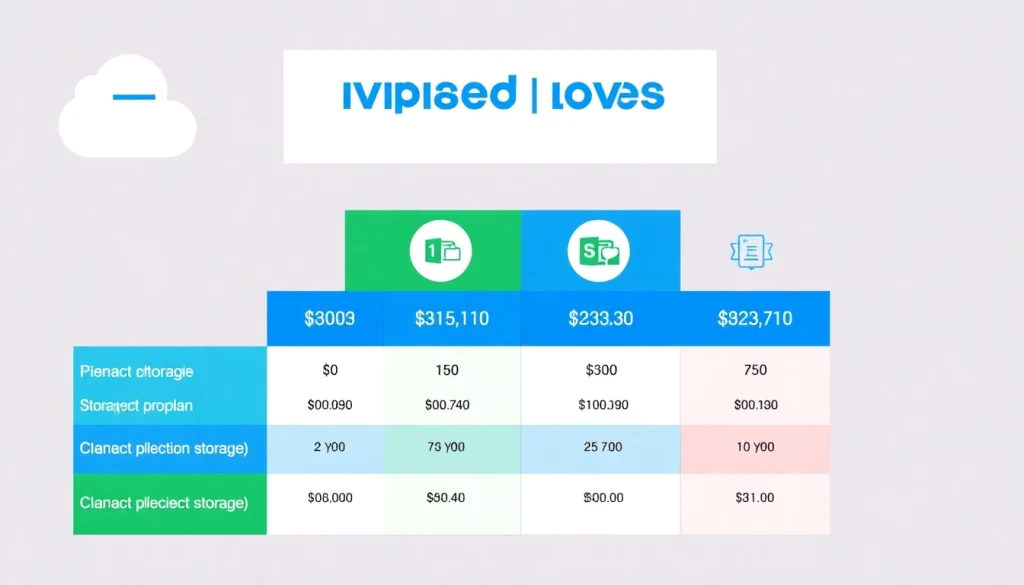
Introduction to OneDrive Costs
Microsoft OneDrive is a cloud storage service that offers a range of plans suitable for various users, from casual individuals to large enterprises. Understanding the Onedrive cost is crucial for users making an informed decision about their file storage and sharing needs. In this article, we will delve into the different pricing tiers offered by OneDrive, assess the cost-effectiveness of each plan, and provide insights and recommendations based on user requirements.
What is OneDrive?
OneDrive is Microsoft’s cloud storage solution that allows users to store files in the cloud, synchronize files across devices, and share files with others. Launched in 2007, OneDrive was initially known as Windows Live SkyDrive but has since evolved significantly. It is integrated seamlessly with Microsoft 365 (formerly Office 365) and Windows operating systems, making it an appealing option for users already within the Microsoft ecosystem. With OneDrive, users can access their files from anywhere, collaborate on documents in real-time, and take advantage of advanced security features.
Why Knowing OneDrive Cost is Important
As digital storage needs continue to grow, knowing the costs associated with cloud services becomes essential. Individuals and businesses must assess whether the investment in additional storage is justified based on their specific needs. Whether you’re using cloud storage for personal backups, collaborative projects, or large-scale business operations, understanding the cost implications of OneDrive will help you choose the best plan for your requirements, avoid unexpected overages, and maximize the value of the service.
Overview of OneDrive Pricing Plans
OneDrive offers a variety of pricing plans that cater to different user needs, including free and paid options. These plans vary by storage capacity, features, and whether they are targeted towards personal or business use. Understanding these plans in detail allows users to identify what best suits their situation, whether it’s a single user looking for personal storage or a team requiring collaborative tools.
OneDrive Free Tier: What You Get
Details of the Free 5GB Storage
OneDrive offers a free tier that comes with 5GB of cloud storage, which is a great introductory option for users who need basic storage capabilities. The free storage can accommodate essential files, documents, photos, and personal backups. With this amount of space, users can store a limited number of high-resolution photos or a few documents without incurring any costs.
Limitations of Free OneDrive Accounts
While the free tier is beneficial, it comes with certain limitations:
- Storage Capacity: 5GB may not be sufficient for users with larger storage requirements, such as photographers or businesses that handle large files.
- Feature Access: Free accounts lack some advanced features available in paid subscriptions, such as offline access, full integration with Microsoft Office applications, and customer support.
- Potential for Overages: Users nearing their storage limit may face difficulties if they forget to manage their storage, leading to potential disruptions in access or functionality.
How to Maximize Your Free Storage
To make the most of the free 5GB offer, users can implement several strategies:
- Selective Usage: Only upload files that truly need cloud backup.
- Regular Cleanup: Periodically review and delete unnecessary files.
- Sharing Options: Use sharing features wisely to reduce the need for duplicate files stored in your OneDrive.
Paid OneDrive Plans: A Comprehensive Guide
Overview of Personal and Family Plans
For users who require more storage, OneDrive offers various paid plans, notably:
- 100GB Plan: Priced at $1.99 per month, this plan is perfect for users needing extra space without all the features of a full Microsoft 365 subscription.
- Microsoft 365 Personal: At $6.99 per month or $69.99 annually, this plan provides 1TB of cloud storage along with access to the latest Office applications like Word, Excel, and PowerPoint.
- Microsoft 365 Family: At $9.99 per month or $99.99 annually, this plan offers all the benefits of the Personal plan for up to six users, making it cost-effective for families or small teams.
Business Plans and Their Costs
For organizations, OneDrive offers robust plans under the Microsoft 365 suite for businesses:
- OneDrive for Business Plan 1: Costs $5 per user per month and includes 1TB of storage per user, perfect for small to medium-sized businesses.
- OneDrive for Business Plan 2: For $10 per user per month, it provides unlimited storage and advanced data loss prevention features, suitable for larger organizations requiring robust compliance and governance tools.
Comparison of OneDrive and Competitors
When considering OneDrive, it’s essential to evaluate its cost against competitors:
- Google Drive: Offers 15GB for free and additional paid tiers starting at $1.99 for 100GB.
- Dropbox: Starts with 2GB of free storage and additional plans around $11.99 per month for 2TB.
Overall, OneDrive remains competitive, particularly for users already engaged with Microsoft products, as the integration significantly enhances productivity and collaboration.
Factors Influencing OneDrive Cost
Type of Subscription: Monthly vs. Annual
Users need to consider whether they opt for a monthly or annual subscription. Annual plans typically offer a slight discount, which can save users money in the long term. Monthly plans provide flexibility for users who may need temporary access or are uncertain about their long-term storage needs.
Storage Capacity Needs
Choosing the right plan ultimately depends on individual storage requirements. For casual users, 100GB may suffice, whereas, for those who handle substantial data volumes—like graphic designers or video editors—a 1TB or even higher capacity subscription may be necessary.
Additional Features and Integrations
Besides storage capacity, users should evaluate additional features, such as:
- Seamless Microsoft Office Integration: Paid subscriptions allow users to collaborate on documents in real-time.
- Security Features: Advanced security measures like two-factor authentication are present in higher-tier plans.
- Support Services: Paid plans usually come with prioritized customer support, which can be invaluable for business users.
Conclusion: Evaluating OneDrive’s Cost Effectiveness
Is OneDrive Worth the Investment?
Assessing the cost-effectiveness of OneDrive depends on users’ specific needs. For individuals and families integrated within the Microsoft ecosystem, the investment can lead to enhanced productivity and convenience. Businesses can significantly benefit from OneDrive’s collaborative features and security offerings, making it a reliable choice for professional workloads.
Final Thoughts on Choosing the Right Plan
When choosing a OneDrive plan, it’s crucial to evaluate both current and future storage needs. Users should not only consider storage limits but also the necessity for additional features, compliance requirements, and overall integration with existing tools. Taking advantage of trial offerings can also help users gauge their needs before committing long-term.
Future of OneDrive Pricing
As cloud storage demands continue to evolve, OneDrive’s pricing structure may adapt to competition and user expectations. Users should stay informed about upcoming changes and explore alternate options if required. With the consistent growth in data usage, knowing the cost aspects will empower users to make the best decisions that align with their technological and financial needs.






